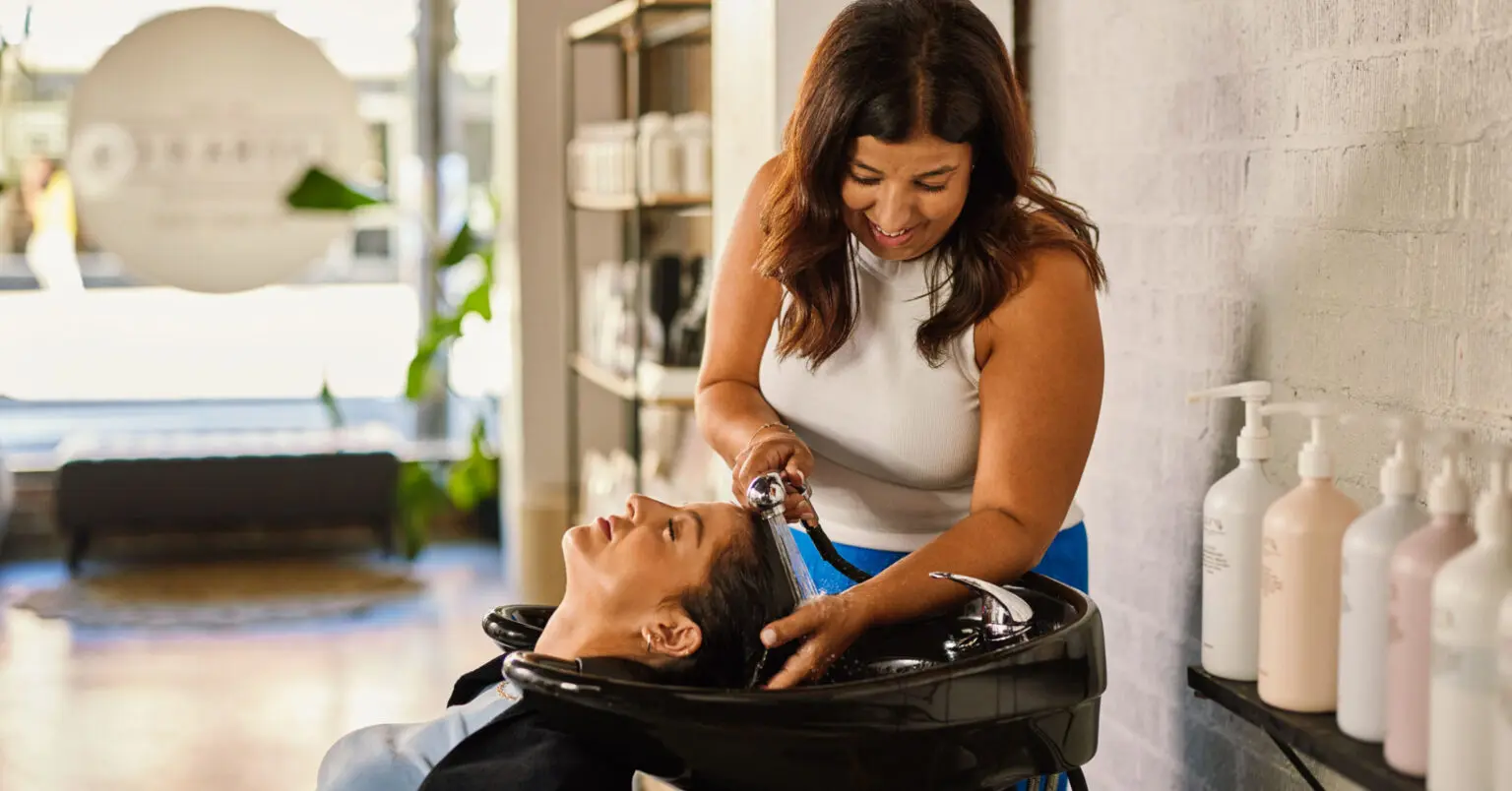Thinking of starting a beauty business from home or buying a salon in NZ? Our guide walks you through the essential steps, from writing a business plan to securing funding for your new business.
At a glance
- Your business plan is the roadmap for your new hair and beauty business, helping you define your unique vision, understand your local market, and prepare your financial forecasts.
- Understanding a few key numbers before you launch, such as typical profit margins, average client spend, and rebooking rates, will help you build a more realistic financial forecast.
- You'll also need to decide on your path to ownership — starting from scratch or buying an existing salon — and have a plan to attract your very first clients.
The ambition to own your own salon often starts quietly, perhaps while perfecting a balayage technique or during a conversation with a loyal client. But the shift from expert practitioner to savvy business owner introduces a new set of challenges: navigating budgets, understanding cash flow, and finding the right funding.
For aspiring owners in New Zealand, the journey typically presents two distinct paths: launching a nimble new venture from home or acquiring an established salon. Success in either journey hinges on a single, non-negotiable element: a robust and well-thought-out plan.
This guide is designed to provide that framework. We’ll walk through the essential steps for structuring your strategy, from mastering the numbers to attracting your first clients and securing the right funding. It’s a practical blueprint designed to bring clarity to the process and help turn your ambition into a thriving business.
Building your hair & beauty business plan
Think of your business plan less as a formal document and more as the story of your future business. While alternative lenders like Prospa may not require a multi-page business plan for their application, the process of creating one is invaluable. It’s about getting your vision down on paper to create a clear path for your first year, giving you the confidence to make smart decisions from day one.
A strong plan for a new salon, spa, or clinic in New Zealand should cover a few core areas.
- Your vision and company description. This is where you outline your mission. What kind of experience will you provide? What makes your business unique in the local market? Define your brand and the values that will guide your decisions. For example, you could position your salon as a quiet, one-on-one retreat for busy professionals, to differentiate from high-volume, family-focused salons in the area.
- Market analysis. This section helps you map out the current industry’s state of play. Who are your ideal clients in your chosen neighbourhood? What are other local salons offering, and where is the gap in the market that your business can fill?
- Services and operations. Detail the specific services you will offer and at what price point. This is also where you plan the practical details, including your location, opening hours, staffing needs, and the suppliers you will work with. You could specialise in advanced curly hair techniques or stock specific product lines that aren’t widely available in your city, creating a clear point of difference.
- Marketing and sales plan. Outline how you will attract your first clients. This part of your plan should detail the strategies you’ll use to build your brand and generate your initial bookings, from creating a social media presence to local networking. Your plan should include ideas like a pre-launch social media campaign that partners with a local fashion boutique to offer a combined “style session” giveaway, building initial hype and a local client list.
- Financial projections. This is the heart of your plan. It includes a detailed breakdown of your startup costs, from your salon fit-out to your initial product stock. It should also include a sales forecast and a cash flow projection for at least your first year of operation.
Ultimately, creating this plan crystallises your most important decisions. It becomes a living document you can return to periodically, helping you track your progress and ensure you are fulfilling, or consciously evolving, your original vision.
The essential numbers for your new salon’s business plan
A key part of your business plan is the financial projections, and understanding the core numbers of the hair and beauty industry is the first step. The true health of a new business is measured by its potential profitability. In New Zealand, industry analysis from IBISWorld shows that net profit margins typically range from 8% to 15%.
Achieving and exceeding that margin depends on managing the key drivers of profit. Here are the core Key Performance Indicators (KPIs) to build your financial forecasts around.
- Average client spend. A crucial metric is the average amount a client spends per visit. Recent reports indicate New Zealanders spend an average of $161 for a cut, colour, and blow dry in salons. A strong per-visit spend is essential, and tracking this number allows you to assess the value of each appointment and refine your pricing strategy.
- Retail sales ratio. A powerful way to improve profitability is through retail. Industry consultants advise aiming for retail sales to contribute
20–30% of your total income in a well-performing salon. This creates an important extra source of income and shows why it’s so valuable when your team can confidently recommend the right products. - Rebooking rate. Predictable revenue is built on repeat business. According to recent NZ salon benchmarks from Kitomba, the average rebooking rate is 57% for hair and 47% for beauty salons. Focusing on a great rebooking process from your very first client is a straightforward way to build a stable financial foundation.
To create a business plan that clearly outlines your vision and strategy, start with the New Zealand government’s business planning guide.
Should you start from scratch or buy an existing salon?
Once your business plan begins to take shape, one of the first big decisions is how you’ll enter the market. You could either start your own business from scratch or buy an existing salon.
Starting from scratch
Launching a new venture gives you complete creative control. You get to choose everything, from the colour on the walls and the music you play to the exact product lines you want to stock. This path often has a lower initial cost, especially if you begin by running a beauty business from home. The primary challenge is that it takes time to build a client base and generate a steady income, as you are creating all your systems and brand recognition from the ground up.
Buying an established salon
The major advantage of buying an existing salon is immediate cash flow. From day one, you have clients walking through the door, a team of stylists in place, and a proven track record of revenue. The upfront investment is typically higher, and you may inherit existing problems, such as a poor reputation or outdated equipment. The key to this path is due diligence. You need to thoroughly investigate the salon’s financial records, staff contracts, and local reputation before you commit.
Neither route is better than the other. The right choice depends on your personal vision, your budget, and your appetite for risk.
Your Path to Ownership: Starting vs. Buying
| Starting from scratch | Buying an established salon | |
| Pros |
|
|
| Cons |
|
|
Attracting and retaining your first clients
Your skills are sharp and your salon is ready, but a new business’s success is ultimately measured by its ability to build a strong client base. You can start building demand and a list of potential clients well before your official opening day.
Before you open your doors
Pre-launch, your focus should be on establishing a presence for your business, both in your local community and in the digital world.
- Set up your Google Business profile. Claim and fully optimise your free profile at least a month before you launch. Add high-quality photos, a full menu of your services, and your contact details. This ensures you are visible on local maps and in search results from the moment you open.
- Build pre-launch hype on social media. Choose one or two visual platforms like Instagram or Facebook and start sharing your journey. Post about your salon’s fit-out, the product lines you’ll be using, and introduce yourself. Create a “founding members” offer with an exclusive discount for the first 20 clients who book an appointment to build an initial client list. To help you plan this, our guide shows you how to create a simple social media strategy in just 60 minutes.
- Connect with your local community. Even before you open, start introducing yourself to the owners of nearby, non-competing businesses. A friendly introduction over a coffee can lay the groundwork for the local partnership and referral network you’ll build once you’re open.
In your first three months
Once you are open, the focus shifts to building reputation and word-of-mouth.
- Launch a referral program immediately. From your very first client, encourage word-of-mouth by rewarding it. Offer both the existing client and their referred friend a tangible benefit, such as a discount or a complimentary add-on service for their next appointment.
- Build a local partnership Formalise the connections you made pre-launch by creating a reciprocal referral program. Offer the customers of your partner businesses (like a nearby boutique or cafe) an exclusive introductory discount, and provide the same for their staff to encourage word-of-mouth.
- Focus on social proof. Meticulously document your work. High-quality before-and-after photos and video testimonials from your first happy clients are your most convincing marketing assets and should play an important role in the social media calendar you develop.
Funding your new hair & beauty business
Whether you’re starting from scratch or buying an established salon, the most critical question is often: how will you fund it? Securing the right capital is what turns your business plan from a document into a reality, providing the funds for everything from your salon fit-out to your first order of stock.
For a new business, understanding your main funding options is the next step. Two of the most common solutions are a business loan and a line of credit.
Business loan
A business loan provides the lump sum capital needed for major launch or acquisition costs. Here’s how it works: you receive the full amount upfront and repay it with regular, predictable instalments over a fixed period, with interest charged on the total amount borrowed.
This structure is often used for a single, planned investment, like the purchase price of an existing salon or the fit-out for your new space. As this is a significant step, it’s worth learning 5 practical tips to improve your chances of getting approved for a small business loan.
Line of credit
A business line of credit offers more flexibility for the unpredictable costs of a new business. It works like a revolving credit facility: you get approved for a total credit limit, draw down funds as you need them, and only pay interest on the money you are using. Once you repay the amount you’ve used, your full credit limit becomes available to you again.
This makes it ideal for buying your initial product stock, covering marketing costs for your launch, or managing cash flow in the first few months before your client base is fully established.
Choosing the right funding is a strategic decision that depends on your specific launch plan. To investigate these and other funding options in more detail, explore a complete guide to business loans and financing options for New Zealand businesses.
Ready to take your salon to the next level? Check how much you could borrow with Prospa in minutes.




